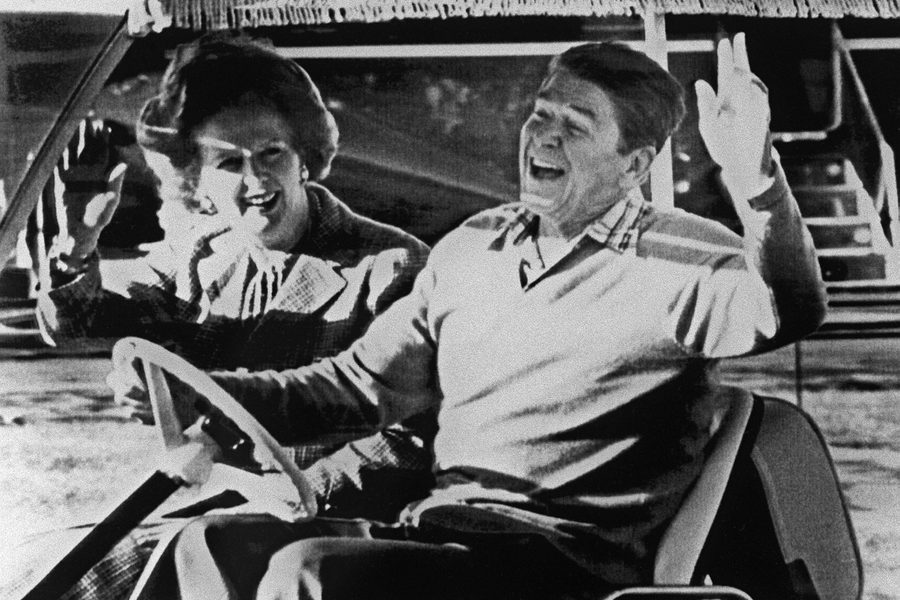
Many coal-fired power plants in the United States are closing because of cheap natural gas prices, and while the closings are cheered for environmental and health reasons, some unions lament the loss of jobs. Many who are happy to see coal plants close are also frustrated that the change is driven by a rush for gas that could curb investment in clean wind power and the “green jobs” mass wind farm construction could create. Others mourn waning interest in the development of “clean coal” technology that arguably could let the United States tap its vast domestic coal reserves more responsibly.
Three decades ago, Great Britain had its own “Dash for Gas,” during which coal power plants and coal mines were closed as the country turned to natural gas to generate electricity. But the primary motive then was neither cheap and abundant natural gas nor environmental concern. Rather, it was then-Prime Minister Margaret Thatcher’s determined campaign to smash the powerful National Union of Mineworkers (NUM) and the labor movement in general, and to privatize public industries.
Given current conversations about our energy futures in the United States and worldwide —not to mention scandals in British media and U.S. battles over public union rights — I think it is worth revisiting the 2009 book, Shafted: The Media, The Miners Strike and the Aftermath.
Edited by Granville Williams, this compilation explores the role of spin, solidarity and strategy in the bitter 1984-1985 strike by miners and sympathetic union members as the Thatcher government and police acting on its behalf moved to gut the miners union and close many coal mines. Chapters written by prominent journalists and others detail the seedy ethics of many mainstream media outlets; the role of alternative media; early examples of community and “citizen journalism;” and the power of propaganda and popular organizing wielded by various parties to the conflict.
There are juicy and shameful examples of media outlets’ questionable ethics and bald partisanship, juxtaposed with the solidarity stands of union journalists and printers who refused to publish slanderous propaganda or who invoked equal-time policies to demand the miners be given a chance to tell their side.
The book notes The Sun’s plans to publish a photo of union leader Arthur Scargill cropped to make it appear he was doing a Nazi salute, The Daily Mirror’s claims that union leaders paid their mortgages with Libyan cash when they didn’t even have mortgages, and the BBC’s manipulation of camera footage to make it appear miners rather than police were the first to become violent in the seminal clash at Orgreaves.
Regarding the Libyan story, which was supplied by a union staffer who approached the tabloid, author Robin Ramsay notes wryly, “Ah, the logic of the tabloid journalist: he didn’t ask for money, so he must be telling the truth.”
Shafted, published with a grant from the Campaign for Press and Broadcasting Freedom, criticizes journalistic laziness and the lack of context that plagued even the less-abhorrent coverage. For example, the Tory government’s statements about the “uneconomic” nature of certain union mines and the wisdom of burning up limited North Sea gas reserves in lieu of coal went unquestioned, according to Shafted, and the conflict was too often portrayed as a battle between colorful adversaries (namely Thatcher and Scargill) than a showdown that would determine the well-being of working people for many years to come.
As a counter to most of the mainstream media’s performance, Shafted celebrates the role of the grassroots alternative media, the NUM’s own journal, and documentaries and articles by miners and community members, produced with the help of grassroots media organizations and the public Channel 4.
The book notes that journalists at alternative outlets with names like Leeds Other Paper, Islington Gutter Press and Sheep Worrying could personally relate to the DIY mentality and sense of mission and passion of the union miners and their supporters. Along with print media, the book also examines music, poetry and major movies like Billy Elliott and The Full Monty. It catalogues the use of music to raise funds and awareness, from local punk shows to benefits by the likes of Chumbawumba and Billy Bragg.
One chapter about movies and plays in decades after the strike describes how popular pieces like Billy Elliott furthered the Thatcherite idea of individualism triumphing over collectivism, and the glossing over of the impacts on depressed “pit villages” where to paraphrase sources, now heroin instead of coal runs in the veins of youth.
Perhaps the most insightful chapter is a soul-searching essay by former BBC journalist Nicholas Jones, who looks back with dismay at how he and other journalists unquestioningly bought into the Thatcher narrative of militant trade unions as the “enemy within.” He takes a more nuanced view than other contributors of mainstream media’s performance, and notes that union leader Scargill’s portrayal of the media as the enemy was counter-productive since it meant journalists were often received with scorn or violence in pit villages, and thus understandably less likely to tell the people’s stories. (Other chapters also describe how police brutally attacked and arrested journalists trying to report objectively on the conflict.)
Jones also describes how the birth of the 24-hour highly competitive news cycle contributed to flawed coverage of the strike, and dissects why media coverage of mass protests against more pit closures in the early 1990s was by contrast highly sympathetic to the miners. Jones writes:
With the benefit of hindsight, and subsequent evidence of a vindictive pit closure programme which continued during the decade which followed the strike, perhaps the news media should own up to a collective failure of judgment comparative to that during the buildup to the Iraq war.
Kari Lydersen is a Chicago-based journalist, author and assistant professor at Northwestern University, where she leads the investigative specialization at the Medill School of Journalism, Media, Integrated Marketing Communications. Her books include Mayor 1%: Rahm Emanuel and the Rise of Chicago’s 99%.








